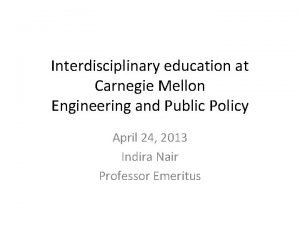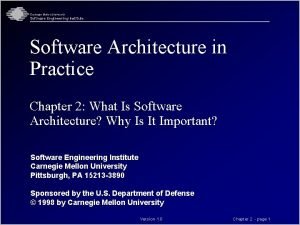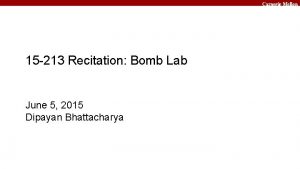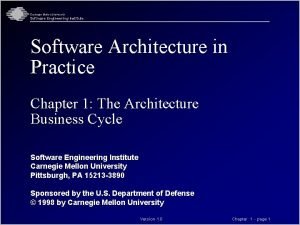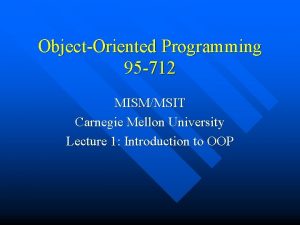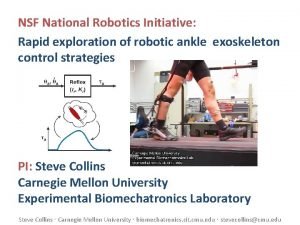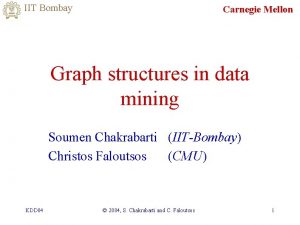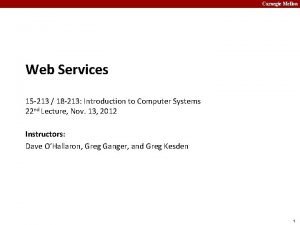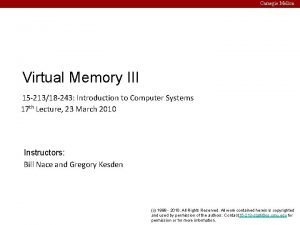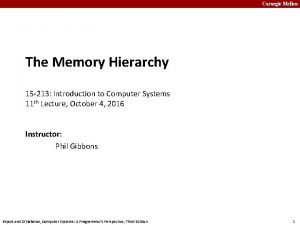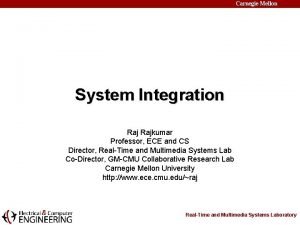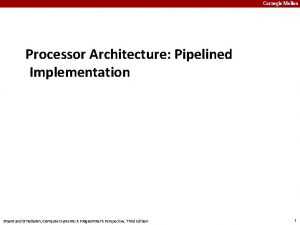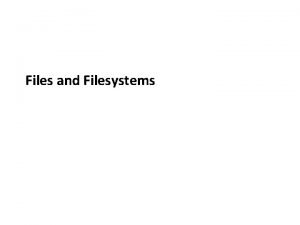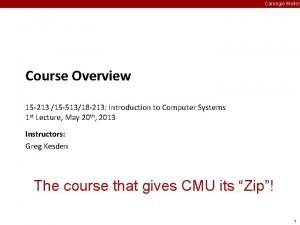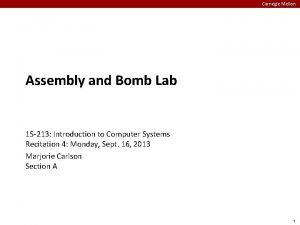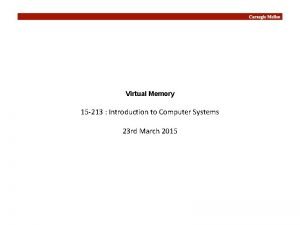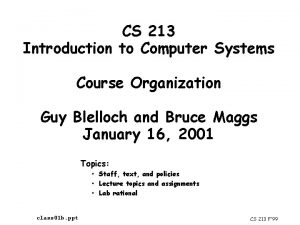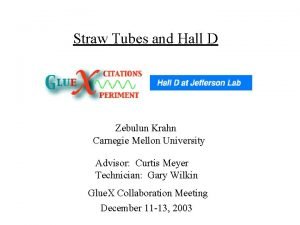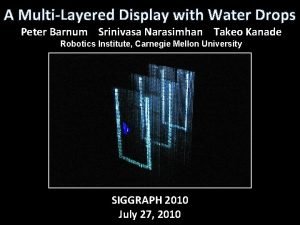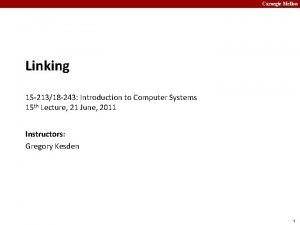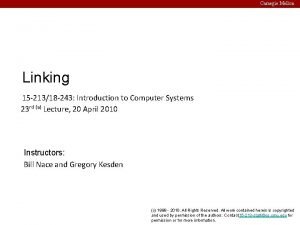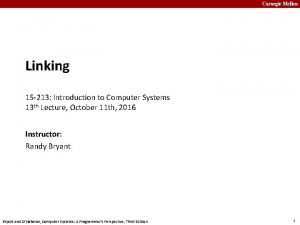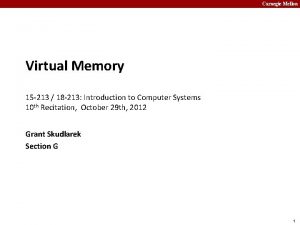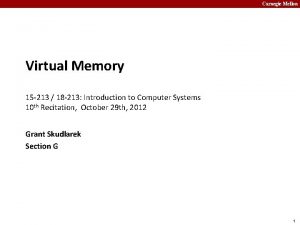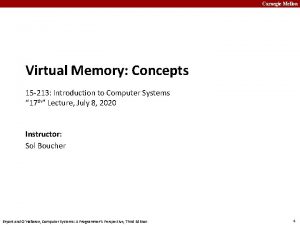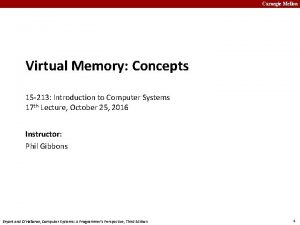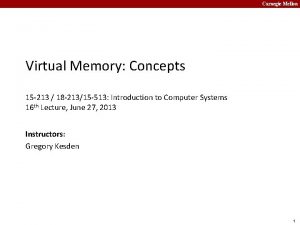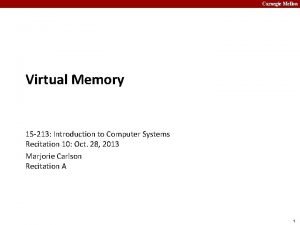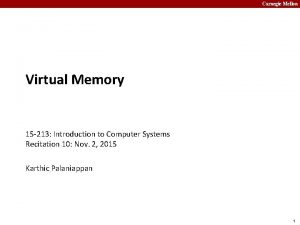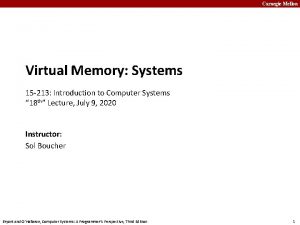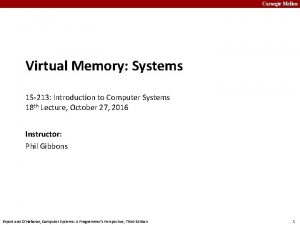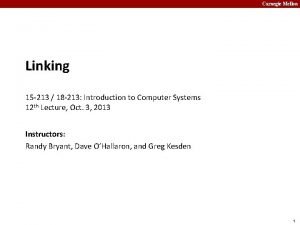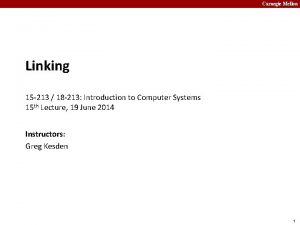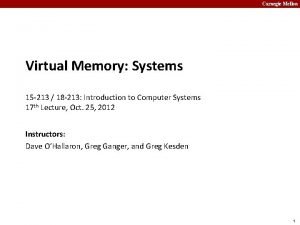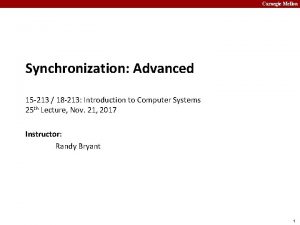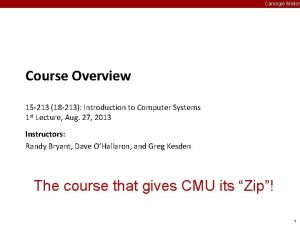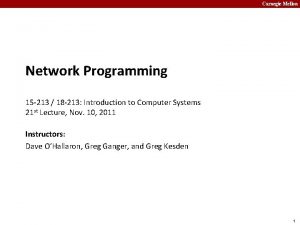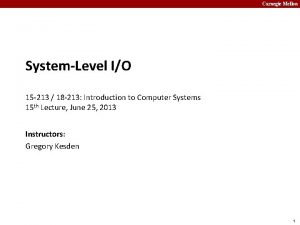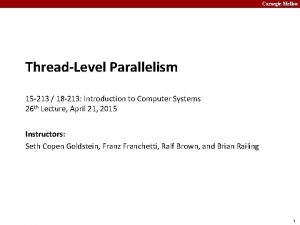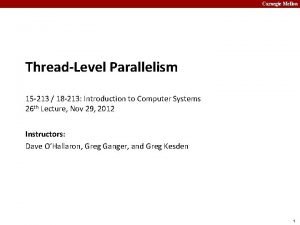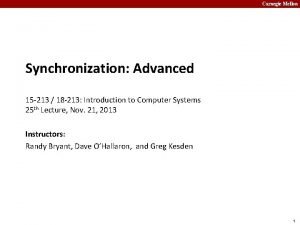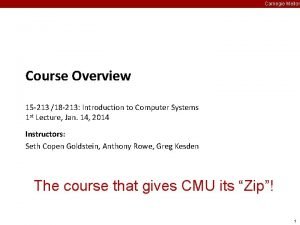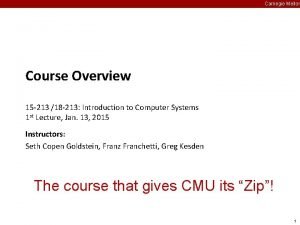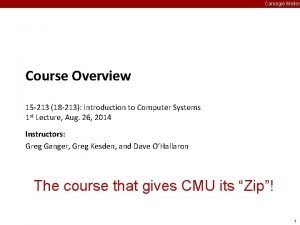Carnegie Mellon Virtual Memory Concepts 15 213 Introduction




































- Slides: 36

Carnegie Mellon Virtual Memory: Concepts 15 -213: Introduction to Computer Systems 16 th Lecture, Oct. 22, 2013 Instructors: Randy Bryant, Dave O’Hallaron, and Greg Kesden 1

Carnegie Mellon Today ¢ ¢ ¢ Address spaces VM as a tool for caching VM as a tool for memory management VM as a tool for memory protection Address translation 2

Carnegie Mellon A System Using Physical Addressing CPU Physical address (PA) 4 . . . Main memory 0: 1: 2: 3: 4: 5: 6: 7: 8: M-1: Data word ¢ Used in “simple” systems like embedded microcontrollers in devices like cars, elevators, and digital picture frames 3

Carnegie Mellon A System Using Virtual Addressing CPU Chip CPU Virtual address (VA) 4100 MMU Physical address (PA) 4 . . . Main memory 0: 1: 2: 3: 4: 5: 6: 7: 8: M-1: Data word ¢ ¢ Used in all modern servers, desktops, and laptops One of the great ideas in computer science 4

Carnegie Mellon Address Spaces ¢ ¢ ¢ Linear address space: Ordered set of contiguous non-negative integer addresses: {0, 1, 2, 3 … } Virtual address space: Set of N = 2 n virtual addresses {0, 1, 2, 3, …, N-1} Physical address space: Set of M = 2 m physical addresses {0, 1, 2, 3, …, M-1} Clean distinction between data (bytes) and their attributes (addresses) Each object can now have multiple addresses Every byte in main memory: one physical address, one (or more) virtual addresses 5

Carnegie Mellon Why Virtual Memory (VM)? ¢ Uses main memory efficiently § Use DRAM as a cache for the parts of a virtual address space ¢ Simplifies memory management § Each process gets the same uniform linear address space ¢ Isolates address spaces § One process can’t interfere with another’s memory § User program cannot access privileged kernel information 6

Carnegie Mellon Today ¢ ¢ ¢ Address spaces VM as a tool for caching VM as a tool for memory management VM as a tool for memory protection Address translation 7

Carnegie Mellon VM as a Tool for Caching ¢ ¢ Virtual memory is an array of N contiguous bytes stored on disk. The contents of the array on disk are cached in physical memory (DRAM cache) § These cache blocks are called pages (size is P = 2 p bytes) Virtual memory VP 0 Unallocated VP 1 Cached VP 2 n-p-1 Uncached Unallocated Cached Uncached Physical memory 0 0 Empty PP 0 PP 1 Empty M-1 PP 2 m-p-1 N-1 Virtual pages (VPs) stored on disk Physical pages (PPs) cached in DRAM 8

Carnegie Mellon DRAM Cache Organization ¢ DRAM cache organization driven by the enormous miss penalty § DRAM is about 10 x slower than SRAM § Disk is about 10, 000 x slower than DRAM ¢ Consequences § Large page (block) size: typically 4 -8 KB, sometimes 4 MB § Fully associative Any VP can be placed in any PP § Requires a “large” mapping function – different from CPU caches § Highly sophisticated, expensive replacement algorithms § Too complicated and open-ended to be implemented in hardware § Write-back rather than write-through § 9

Carnegie Mellon Page Tables ¢ A page table is an array of page table entries (PTEs) that maps virtual pages to physical pages. § Per-process kernel data structure in DRAM Physical page number or Valid disk address PTE 0 0 null 1 1 0 0 PTE 7 1 null Physical memory (DRAM) VP 1 VP 2 VP 7 VP 4 PP 0 PP 3 Virtual memory (disk) VP 1 Memory resident page table (DRAM) VP 2 VP 3 VP 4 VP 6 VP 7 10

Carnegie Mellon Page Hit ¢ Page hit: reference to VM word that is in physical memory (DRAM cache hit) Virtual address Physical page number or Valid disk address PTE 0 0 null 1 1 0 0 PTE 7 1 null Physical memory (DRAM) VP 1 VP 2 VP 7 VP 4 PP 0 PP 3 Virtual memory (disk) VP 1 Memory resident page table (DRAM) VP 2 VP 3 VP 4 VP 6 VP 7 11

Carnegie Mellon Page Fault ¢ Page fault: reference to VM word that is not in physical memory (DRAM cache miss) Virtual address Physical page number or Valid disk address PTE 0 0 null 1 1 0 0 PTE 7 1 null Physical memory (DRAM) VP 1 VP 2 VP 7 VP 4 PP 0 PP 3 Virtual memory (disk) VP 1 Memory resident page table (DRAM) VP 2 VP 3 VP 4 VP 6 VP 7 12

Carnegie Mellon Handling Page Fault ¢ Page miss causes page fault (an exception) Virtual address Physical page number or Valid disk address PTE 0 0 null 1 1 0 0 PTE 7 1 null Physical memory (DRAM) VP 1 VP 2 VP 7 VP 4 PP 0 PP 3 Virtual memory (disk) VP 1 Memory resident page table (DRAM) VP 2 VP 3 VP 4 VP 6 VP 7 13

Carnegie Mellon Handling Page Fault ¢ ¢ Page miss causes page fault (an exception) Page fault handler selects a victim to be evicted (here VP 4) Virtual address Physical page number or Valid disk address PTE 0 0 null 1 1 0 0 PTE 7 1 null Physical memory (DRAM) VP 1 VP 2 VP 7 VP 4 PP 0 PP 3 Virtual memory (disk) VP 1 Memory resident page table (DRAM) VP 2 VP 3 VP 4 VP 6 VP 7 14

Carnegie Mellon Handling Page Fault ¢ ¢ Page miss causes page fault (an exception) Page fault handler selects a victim to be evicted (here VP 4) Virtual address Physical page number or Valid disk address PTE 0 0 null 1 1 1 0 0 0 PTE 7 1 null Physical memory (DRAM) VP 1 VP 2 VP 7 VP 3 PP 0 PP 3 Virtual memory (disk) VP 1 Memory resident page table (DRAM) VP 2 VP 3 VP 4 VP 6 VP 7 15

Carnegie Mellon Handling Page Fault ¢ ¢ ¢ Page miss causes page fault (an exception) Page fault handler selects a victim to be evicted (here VP 4) Offending instruction is restarted: page hit! Virtual address Physical page number or Valid disk address PTE 0 0 null 1 1 1 0 0 0 PTE 7 1 null Physical memory (DRAM) VP 1 VP 2 VP 7 VP 3 PP 0 PP 3 Virtual memory (disk) VP 1 Memory resident page table (DRAM) VP 2 VP 3 VP 4 VP 6 VP 7 16

Carnegie Mellon Locality to the Rescue Again! ¢ ¢ Virtual memory works because of locality At any point in time, programs tend to access a set of active virtual pages called the working set § Programs with better temporal locality will have smaller working sets ¢ If (working set size < main memory size) § Good performance for one process after compulsory misses ¢ If ( SUM(working set sizes) > main memory size ) § Thrashing: Performance meltdown where pages are swapped (copied) in and out continuously 17

Carnegie Mellon Today ¢ ¢ ¢ Address spaces VM as a tool for caching VM as a tool for memory management VM as a tool for memory protection Address translation 18

Carnegie Mellon VM as a Tool for Memory Management ¢ Key idea: each process has its own virtual address space § It can view memory as a simple linear array § Mapping function scatters addresses through physical memory § Well chosen mappings simplify memory allocation and management Virtual Address Space for Process 1: 0 VP 1 VP 2 Address translation 0 PP 2 . . . Physical Address Space (DRAM) N-1 PP 6 Virtual Address Space for Process 2: 0 PP 8 VP 1 VP 2 . . . N-1 (e. g. , read-only library code) M-1 19

Carnegie Mellon VM as a Tool for Memory Management ¢ Memory allocation § Each virtual page can be mapped to any physical page § A virtual page can be stored in different physical pages at different times ¢ Sharing code and data among processes § Map virtual pages to the same physical page (here: PP 6) Virtual Address Space for Process 1: 0 VP 1 VP 2 Address translation 0 PP 2 . . . Physical Address Space (DRAM) N-1 PP 6 Virtual Address Space for Process 2: 0 PP 8 VP 1 VP 2 . . . N-1 (e. g. , read-only library code) M-1 20

Carnegie Mellon Simplifying Linking and Loading Kernel virtual memory ¢ Linking 0 xc 0000000 § Each program has similar virtual User stack (created at runtime) address space § Code, stack, and shared libraries always start at the same address Memory invisible to user code %esp (stack pointer) Memory-mapped region for shared libraries 0 x 40000000 ¢ Loading § execve() allocates virtual pages for. text and. data sections = creates PTEs marked as invalid § The. text and. data sections are copied, page by page, on demand by the virtual memory system Run-time heap (created by malloc) Read/write segment (. data, . bss) Read-only segment (. init, . text, . rodata) 0 x 08048000 0 brk Loaded from the executable file Unused 21

Carnegie Mellon Today ¢ ¢ ¢ Address spaces VM as a tool for caching VM as a tool for memory management VM as a tool for memory protection Address translation 22

Carnegie Mellon VM as a Tool for Memory Protection ¢ ¢ Extend PTEs with permission bits Page fault handler checks these before remapping § If violated, send process SIGSEGV (segmentation fault) Process i: SUP VP 0: VP 1: VP 2: No No Yes READ WRITE Yes Yes No Yes • • • Address PP 6 PP 4 PP 2 Physical Address Space PP 2 PP 4 PP 6 Process j: SUP VP 0: VP 1: VP 2: No Yes No READ WRITE Yes Yes No Yes Address PP 9 PP 6 PP 11 PP 8 PP 9 PP 11 23

Carnegie Mellon Today ¢ ¢ ¢ Address spaces VM as a tool for caching VM as a tool for memory management VM as a tool for memory protection Address translation 24

Carnegie Mellon VM Address Translation ¢ Virtual Address Space § V = {0, 1, …, N– 1} ¢ Physical Address Space § P = {0, 1, …, M– 1} ¢ Address Translation § MAP: V P U { } § For virtual address a: MAP(a) = a’ if data at virtual address a is at physical address a’ in P § MAP(a) = if data at virtual address a is not in physical memory – Either invalid or stored on disk § 25

Carnegie Mellon Summary of Address Translation Symbols ¢ ¢ ¢ Basic Parameters § N = 2 n : Number of addresses in virtual address space § M = 2 m : Number of addresses in physical address space § P = 2 p : Page size (bytes) Components of the virtual address (VA) § TLBI: TLB index § TLBT: TLB tag § VPO: Virtual page offset § VPN: Virtual page number Components of the physical address (PA) § PPO: Physical page offset (same as VPO) § PPN: Physical page number § CO: Byte offset within cache line § CI: Cache index § CT: Cache tag 26

Carnegie Mellon Address Translation With a Page Table Virtual address n-1 Page table base register (PTBR) Page table address for process Virtual page number (VPN) p p-1 0 Virtual page offset (VPO) Page table Valid Physical page number (PPN) Valid bit = 0: page not in memory (page fault) m-1 Physical page number (PPN) p p-1 0 Physical page offset (PPO) Physical address 27

Carnegie Mellon Address Translation: Page Hit 2 PTEA CPU Chip CPU 1 VA PTE MMU 3 PA Cache/ Memory 4 Data 5 1) Processor sends virtual address to MMU 2 -3) MMU fetches PTE from page table in memory 4) MMU sends physical address to cache/memory 5) Cache/memory sends data word to processor 28

Carnegie Mellon Address Translation: Page Fault Exception 4 2 PTEA CPU Chip CPU 1 VA 7 Page fault handler MMU PTE 3 Victim page Cache/ Memory 5 Disk New page 6 1) Processor sends virtual address to MMU 2 -3) MMU fetches PTE from page table in memory 4) Valid bit is zero, so MMU triggers page fault exception 5) Handler identifies victim (and, if dirty, pages it out to disk) 6) Handler pages in new page and updates PTE in memory 7) Handler returns to original process, restarting faulting instruction 29

Carnegie Mellon Integrating VM and Cache PTE CPU Chip PTEA CPU PTEA hit VA MMU PTEA miss PA PA miss PA Memory Data PA hit Data PTEA L 1 cache VA: virtual address, PA: physical address, PTE: page table entry, PTEA = PTE address 30

Carnegie Mellon Speeding up Translation with a TLB ¢ Page table entries (PTEs) are cached in L 1 like any other memory word § PTEs may be evicted by other data references § PTE hit still requires a small L 1 delay ¢ Solution: Translation Lookaside Buffer (TLB) § Small hardware cache in MMU § Maps virtual page numbers to physical page numbers § Contains complete page table entries for small number of pages 31

Carnegie Mellon TLB Hit CPU Chip CPU TLB 2 PTE VPN 3 1 VA MMU PA 4 Cache/ Memory Data 5 A TLB hit eliminates a memory access 32

Carnegie Mellon TLB Miss CPU Chip TLB 2 4 PTE VPN CPU 1 VA MMU 3 PTEA PA Cache/ Memory 5 Data 6 A TLB miss incurs an additional memory access (the PTE) Fortunately, TLB misses are rare. Why? 33

Carnegie Mellon Multi-Level Page Tables ¢ Suppose: § 4 KB (212) page size, 48 -bit address space, 8 -byte PTE ¢ Problem: § Would need a 512 GB page table! § Level 2 Tables Level 1 Table 248 * 2 -12 * 23 = 239 bytes. . . ¢ Common solution: § Multi-level page tables § Example: 2 -level page table Level 1 table: each PTE points to a page table (always memory resident) § Level 2 table: each PTE points to a page (paged in and out like any other data) . . . § 34

Carnegie Mellon A Two-Level Page Table Hierarchy Level 1 page table Level 2 page tables Virtual memory VP 0 PTE 1 . . . PTE 2 (null) PTE 1023 PTE 3 (null) PTE 0 PTE 5 (null) . . . PTE 6 (null) PTE 1023 VP 1024 2 K allocated VM pages for code and data . . . Gap PTE 7 (null) (1 K - 9) null PTEs . . . VP 2047 PTE 4 (null) PTE 8 0 6 K unallocated VM pages 1023 null PTEs PTE 1023 . . . 32 bit addresses, 4 KB pages, 4 -byte PTEs 1023 unallocated pages VP 9215 1023 unallocated pages 1 allocated VM page for the stack 35

Carnegie Mellon Summary ¢ Programmer’s view of virtual memory § Each process has its own private linear address space § Cannot be corrupted by other processes ¢ System view of virtual memory § Uses memory efficiently by caching virtual memory pages Efficient only because of locality § Simplifies memory management and programming § Simplifies protection by providing a convenient interpositioning point to check permissions § 36
 Cmu computational biology
Cmu computational biology Carnegie mellon interdisciplinary
Carnegie mellon interdisciplinary Carnegie mellon software architecture
Carnegie mellon software architecture Cmu bomb threat
Cmu bomb threat Carnegie mellon software architecture
Carnegie mellon software architecture Cmu citi training
Cmu citi training Mism carnegie mellon
Mism carnegie mellon Randy pausch carnegie mellon
Randy pausch carnegie mellon Robotic ankle
Robotic ankle Carnegie mellon
Carnegie mellon 18-213 cmu
18-213 cmu Cmu vpn
Cmu vpn Carnegie mellon
Carnegie mellon Carnegie mellon
Carnegie mellon Carnegie mellon
Carnegie mellon Carnegie mellon
Carnegie mellon Carnegie mellon fat letter
Carnegie mellon fat letter Cmu 15-513
Cmu 15-513 Cmu bomb lab
Cmu bomb lab Page fault
Page fault Virtual memory in memory hierarchy consists of
Virtual memory in memory hierarchy consists of 15-213 introduction to computer systems
15-213 introduction to computer systems 15-213 introduction to computer systems
15-213 introduction to computer systems Mellon serbia iskustva
Mellon serbia iskustva Carneigh mellon
Carneigh mellon Christina mellon
Christina mellon Wageworks health equity
Wageworks health equity Zebulun krahn
Zebulun krahn Water mellon
Water mellon Mellon elf
Mellon elf Mellon elf
Mellon elf Mellon elf
Mellon elf Basic concepts of memory
Basic concepts of memory Basic concepts of memory
Basic concepts of memory Spreading activation psychology
Spreading activation psychology Excplicit memory
Excplicit memory Long term memory vs short term memory
Long term memory vs short term memory

